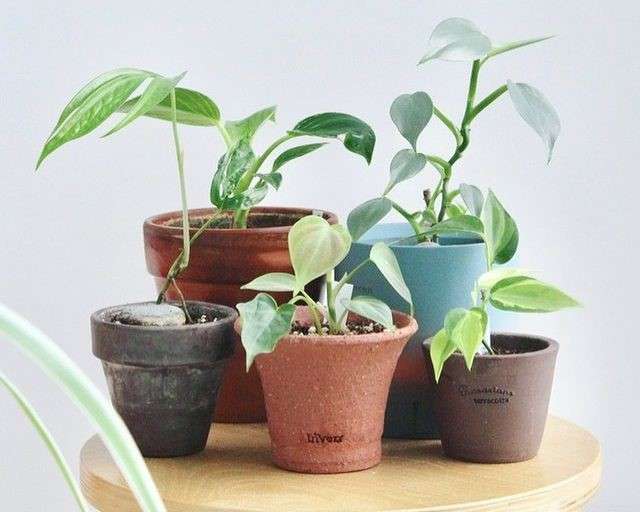Table of Contents
Do you love plants and want to nurture them so they can thrive in your home? If the answer is yes, you’ll be glad to hear that an entire philodendron community is just waiting for you to take care of them.
Plants are some of the most common household fixtures, and at least 8 million of them are living in American homes as of 2021. There are also many different types and varieties, from succulents to cacti.
You can grow your houseplant by purchasing a small pot or planter from any local nursery. There are so many houseplants out there that knowing which one is best for you may seem overwhelming at first glance. However, keeping houseplants isn’t as challenging as it looks with little research and care.
This article will discuss everything you need to know about caring for your philodendron camposportoanum.
Let’s get started!
What Is Philodendron Camposportoanum?
Philodendron camposportoanum is a plant commonly known as Philodendron Campos. It is a climbing and trailing plant with green leaves that have thin, sharp teeth along the edges.
They grow to be anywhere from three inches to six feet, depending on your variety. The blossom can be brown or white, depending on your type. There are many benefits of having one of these beautiful plants in your home.
For example, they provide an excellent way to reduce indoor air pollution, which can help prevent asthma symptoms and other health concerns in children and adults alike. Because they need little light or water, houseplants are also an excellent choice for environmental stewardship. And since they need a little attention over time, they’re easy to maintain!
Origin And Family
The Philodendron camposportoanum is native to the tropical regions of South America, such as Colombia and Brazil.
It belongs to the genus Philodendron, “to love a plant.”
Botanical Name
The plant’s scientific name, however, is just Philodendron camposportoanum. The difference between these two names is that the scientific name has two parts:
Philcoostephanus camposroatanius. “Philco” comes from the Greek word for loving plants, “kos.”
The second part of the scientific name comes from a Latin word for “a rat,” referring to how it originally grew around a rat’s nest.
Occurrence
Philodendron Camposportoanum can be found in rainforest conditions, but most often, it will grow near water sources because it requires very little water to thrive.
Classification
The classification of Philodendron Camposportoanum involves a meticulous analysis of its botanical traits, habitat, and genetic lineage. This species belongs to the Araceae family and the Philodendron genus and exhibits distinct characteristics, including its unique leaf shape and growth pattern. Researchers categorize it within the subgenus Meconostigma, alongside other Philodendron species with similar morphological features.
Philodendron Camposportoanum’s taxonomic classification is scrutinized through various methods, such as molecular phylogenetics, to ascertain its evolutionary relationships with other plants. Understanding the classification aids in scientific research and horticultural practices, ensuring accurate identification and conservation efforts.
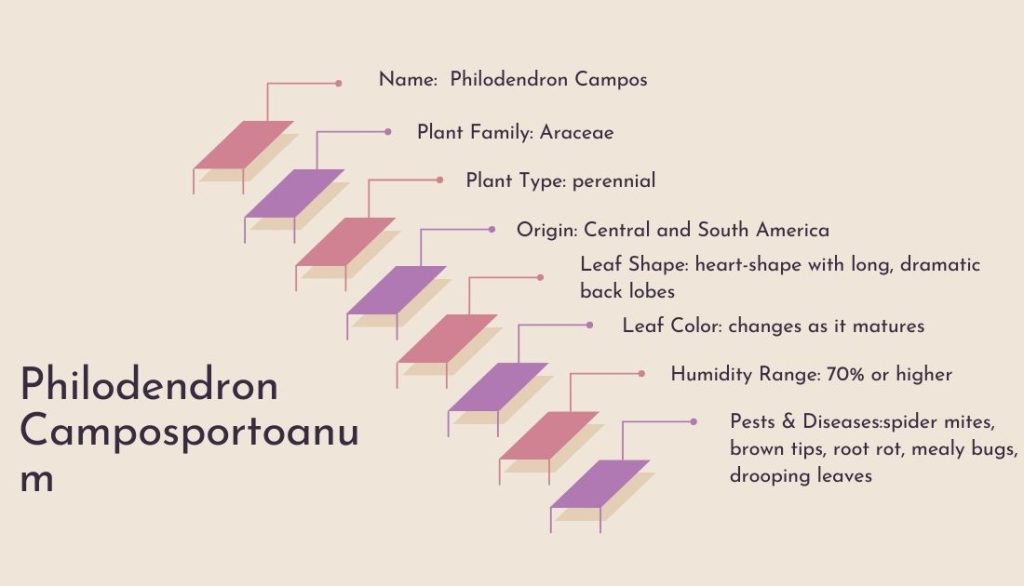
Cultivation And Uses
Philodendron Camposportoanum is a special plant many people love because it’s pretty and easy to care for. It has big, beautiful leaves and needs little attention to grow well.
This plant likes warm, humid places, so it’s perfect indoors or in a greenhouse. To help it develop its best, give it well-draining soil and put it where it gets indirect sunlight. Water it regularly, but let the soil dry out between waterings to keep it healthy.
Besides being nice to look at, Philodendron Camposportoanum also helps clean the air inside your home by removing bad stuff. It’s good for decorating your home and making it look lively.
In some places, people even use it in traditional medicine because they believe it has healing powers. Overall, it’s a great plant to have around for both its looks and its benefits.
Natural Habitat of Philodendron camposportoanum
It’s really important for people who love and study plants to know about where Philodendron camposportoanum lives naturally. This special kind of Philodendron comes from the thick rainforests of South America, specifically from the Campos Porto Alegre area in Brazil, which is why it’s called that.
This plant grows well in its home among the low plants and trees in the rainforest. It is hot and humid, with lots of rain, which is common in tropical places. The soil there is good for it; it gets just the right amount of sunlight through the trees.
The Campos Porto Alegre area has a lot of different plants and animals. Philodendron camposportoanum usually sticks to trees or spreads out on the ground in the forest. It uses its roots in the air to hold onto things and soak up water and nutrients from its surroundings.
Knowing how Philodendron camposportoanum lives in its natural home is crucial for keeping it safe and growing it well. By understanding where it comes from, people can ensure that they create the right environment for it to grow, which helps keep it healthy for the future.
Philodendron Camposportoanum Plant Size
This is one of the smaller species of philodendron. It grows to around six inches tall and is approximately three inches wide. This plant also needs a little bit more water than some other types of plants. If you’re unsure how much water to provide this species, keep in mind that it needs about an inch per week. In terms of light requirements, this plant doesn’t require much light to thrive, as long as it is given enough sunlight or artificial light. The philodendron requires about ten hours a day, but this requirement can be reduced if the plant isn’t receiving enough sunlight or artificial light.
Do you know? Philodendron Camposportoanum is not just pretty; the plant has various health benefits. The leaves contain antioxidants and enzymes, which help digestion, blood circulation, and cell regeneration.
Philodendron Camposportoanum Plant Care Basics
philodendron camposportoanum is a small, leafy plant that’s surprisingly easy to care for. It likes to be kept in full light and thrives on humidity.
Some basic tips for caring for your philodendron will help you keep a happy, healthy plant.
- Keep your philodendron away from drafts and cold drafts as it needs warm temperatures to stay alive.
- Water the plant sparingly because it can dry out quickly. Use lukewarm water rather than hot or cold water because the leaves will be more likely to rot if the temperature is too high or low.
- When you do water, your philodendron ensures enough drainage so the soil doesn’t become soggy, and your plant won’t lose its nutrients.
- Make sure that the soil stays moist throughout the day because this is when the plant will absorb most of its nutrients and moisture.
- If you have a larger philodendron or if there are multiple plants in a container, use only one watering solution at a time, so they each get their dose of nutrients and moisture without diluting anything out of either pot or bottle.
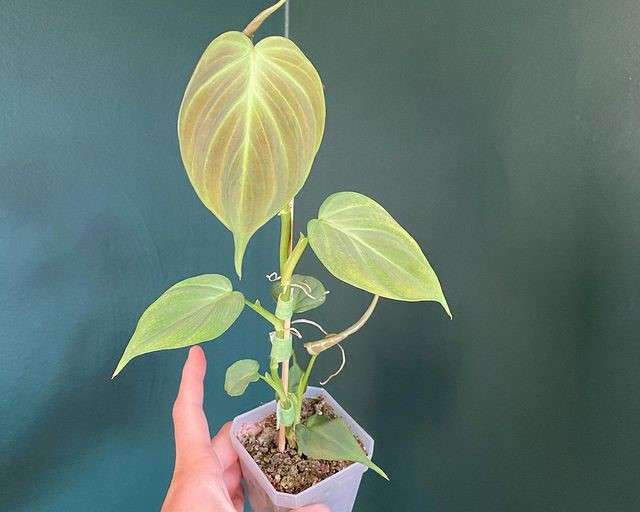
Best Pot Size for Growing Philodendron Camposportoanum
It is important to choose the right pot for your philodendron camposportoanum. One size does not fit all when it comes to planting care, so as a first step, you should determine what size pot is best for your plant.
There are three different sizes of pots you can use:
- Small
- Medium
- Large
Each has its advantages and disadvantages, but whichever size you choose will depend on how the plant will be used.
Small pots:
The benefit of using a small pot is that they are lightweight and easy to handle. This allows you to place philodendron camposportoanum on a table or countertop or even in an area with little floor space. These are also perfect for plants that need more frequent watering than others.
Medium pots:
Medium-sized pots are also lightweight and easy to hold, making them great for indoor plants that need more water than other types, such as arid plants or those that live in areas with fluctuating humidity levels.
Depending on philodendron height, these pots can be placed on tables, counters, or the ground near plants like cacti and succulents.
Large pots:
The advantage of using a large pot is that it adds more depth to the plant’s root system without adding too much weight to the plant itself.
In addition, these pots offer plenty of room for roots to spread out rather than remain clustered together at the bottom of the pot like smaller ones do. This means philodendrons have more surface area where nutrients can be absorbed and waste products excreted. However, the drawback of this type of pot is that it provides too much space for roots to grow, making it difficult for them to hold up the pot when you transplant them into a larger container.
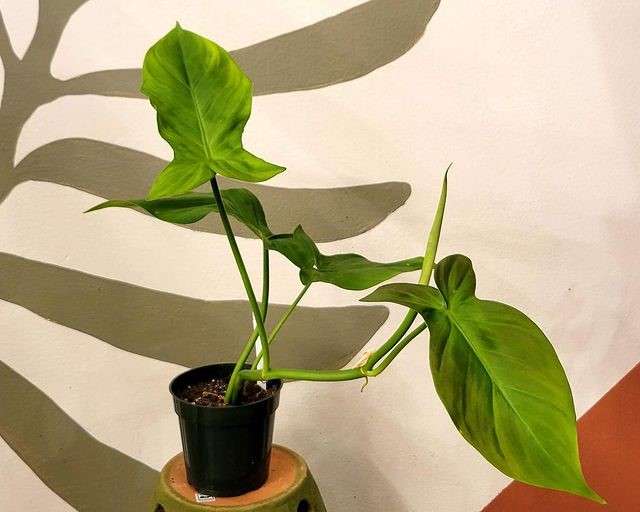
Philodendron Camposportoanum Care Difficulty
There are a few things to keep in mind when caring for your philodendron camposportoanum. First, if you don’t maintain the plant properly, it may die.
- The first thing to remember is that Philodendron Camposportoanum is not a cactus but a succulent. This means that it can store water and grow fat on this stored water. To do so, they often need lots of sunlight and even more specific attention than other types of houseplants or plants.
- The second key aspect of care for philodendron camposportoanum is watering. How often you should be watering the plant and how much water you should give them every time. Allowing the soil to dry out before watering again will help the plant retain moisture and prevent root rot.
- Not to forget about reporting! To keep plants healthy, they need to be repotted from time to time. As new growth emerges, the roots grow and outgrow the container. This is when you will have to transplant them into another container or pot.
Philodendron Camposportoanum Growth Rate
The first step is determining how fast and large the plant will grow. This will depend on how much sunlight it gets and how often you water it.
The philodendron camposportoanum has a growth rate of 12 inches per year. This means that it can reach a height of around 3 feet within four years if given enough light and watered regularly.
If you only give it six hours of direct sunlight per day, however, the length of time it takes for this plant to grow increases to 8 years!
When deciding what type of pot best fits your plant’s needs, remember that bigger pots allow for more water flow through their drainage holes. However, too big a pot may cause the roots to start growing out instead of down towards the soil.
Suppose you want your philodendron camposportoanum to thrive. In that case, you want to ensure that it is fed well with food and plenty of water. This houseplant will flourish into an attractive centerpiece for any home or office space with proper care.
Philodendron Camposportoanum Humidity Requirements
This plant requires high humidity for its optimal health. If your house is already humid, then this plant will thrive. If not, then a humidifier is always an excellent investment for you.
You can also mist the plant often to keep it moist as needed. This plant likes to live in a pot with coarse-grained media and enjoys being outside during the summer months.
However, it should be kept inside during winter when temperatures are below 45 degrees Fahrenheit.
Philodendron Camposportoanum Propagating Requirements
When you’re propagating your Philodendron, you will need to make sure the following things are in order:
Lighting Requirement
The philodendron camposportoanum needs a few hours of sunlight every day to thrive. The plant will benefit from sun exposure in the morning and then again in the evening. When it’s cloudy or cold, keep your plant indoors by giving it artificial light instead of sun exposure.
Watering Needs
If you have philodendron camposportoanum, it’s important to water your plant regularly. The frequency of watering depends on species and climate. In general, you should water your plants from the top down so the water will flow out of the leaves and into the pot. If you need to clean your pot, pour out the old soil before adding new dirt.
Temperature Requirement
The ideal room temperature for philodendron camposportoanum is around 60-75 degrees Fahrenheit, so its leaves don’t curl and turn brown from frostbite. If you’re unsure about the temperature in your home, keep them away from drafts or vents!
But if your home is too cold, wrap your plant in a blanket to increase its sense of warmth.
Humidity Requirement
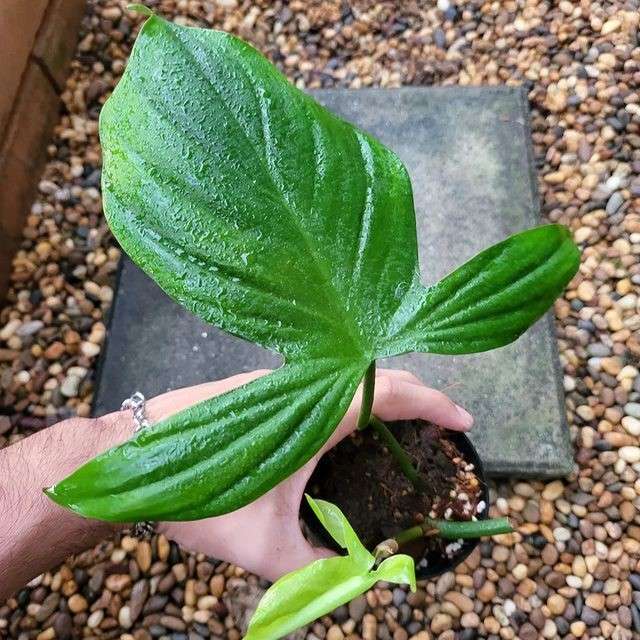
philodendron camposportoanum is a tropical plant that thrives in high-humidity environments. Therefore, keep the humidity levels high to grow healthy. You can accomplish this by using pebbles inside your vase to create humidity around their pot or keep their pots close to a window with a humidifier running nearby.
If you are going to be away for an extended period and worried about your plant being left alone, you can place it in a plastic bag with some uncooked rice and water. That will serve as a temporary care solution until you get back!
Necessary Fertilizer
The philodendron camposportoanum requires little care, but it nonetheless benefits from a regular fertilization routine. To maintain the plant, you must give it a steady fertilizer supply.
The best type of fertilizer for these plants is one with a balanced ratio of nitrogen, phosphorus, and potassium. To ensure this balance, add the appropriate amount of fertilizer. You can use liquid or granular fertilizer, depending on what you prefer.
Growth Zone Needs
The Philodendron Camposportoanum is a plant that thrives in the living room. It can grow up to 8 inches tall and has attractive, variegated green, white, yellow, or red leaves.
- Philodendron likes bright conditions and low light, making it easy to care for them even if you’re limited on space.
- They require little water, so they’re good for plants that don’t need much maintenance but still want to be alive year round.
- As long as the plant is given water regularly, you can expect it to live for up to ten years!
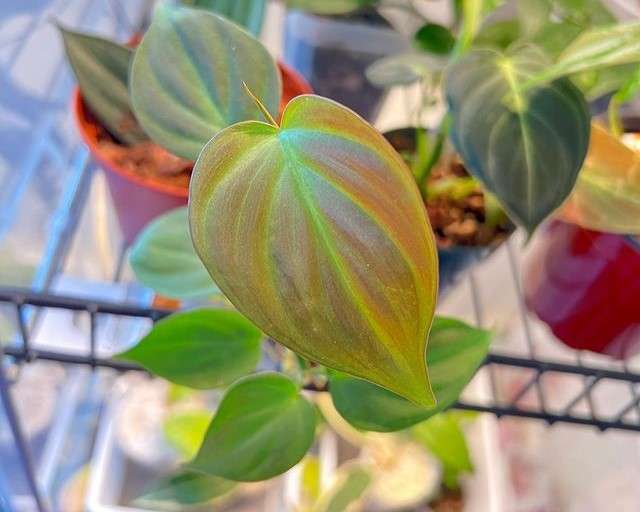
Potting and Pruning
These plants are grown in a variety of different containers.
- For larger Philodendron Camposportoanum, use a hanging basket or clay pot.
- For smaller plants, use a saucer or small pot with drainage holes.
- If you plan on planting your plant outdoors in the ground, be sure to prepare the ground first by digging a hole and adding compost before planting your Philodendron Camposportoanum.
- To help keep the roots healthy, water the plant daily for about an hour and mix in some fertilizer.
- It can also help grow better if you mist it daily with a little water.
- Not crowding these plants is important as they need plenty of space for growth.
- Your garden will enjoy more flowers and better blooming if you provide them proper care from time to time throughout their life cycle.
Pests and their Pesticides:
Philodendron Camposportoanum is a popular houseplant because it is easy to care for and has beautiful foliage. However, this plant can be susceptible to pests, including aphids, mealy bugs, and thrips. These pests can be difficult to eliminate, but some pesticides can be effective.
Aphids and their Pesticides
Aphids are small, green insects that often congregate on the underside of leaves of Philodendron Camposportoanum. When aphids do come along, they will feed on the leaves of your plant and cause brown spots on the leaves or leave behind honeydew which can lead to white mold.
Control: Many different pesticides can be used to control aphids. Some common ones include pyrethrins, malathion, and carbaryl.
Mealy bugs and their Pesticides
Mealy bugs are small, white insects that love the sap from the Philodendron and will secrete their spit while they feast on it. They may also form a sticky webbing around the leaves which will cause serious damage in the long run.
Control: Mealybugs can be controlled with pesticides that contain the active ingredient, imidacloprid.
Thrips and their Pesticides
Thrips are tiny flying insects gathering near flowers where they lay eggs that eventually grow into larvae that eat away at the flowers until there is nothing left but a pile of black specks on your flowerbeds.
Control: A few different pesticides can help control thrips populations. Some of the most common include pyrethrins, malathion, and carbaryl.
TIP: It is important to always read the label of any pesticide before using it to ensure it is safe and effective for the specific pest you are targeting.
Philodendron camposportoanum Diseases
The most common disease is stem rot, which causes the plant’s stem to rot and die. As a result, the leaves will droop, and the plant will eventually die.
Another disease affecting the Philodendron Camposportoanum is root rot, which causes the roots to rot and die. As a result, the plant will lose its leaves and wilt. The plant will eventually die if either of these diseases is left untreated.
Philodendron camposportoanum Problems
Philodendron camposportoanum is a beautiful and popular philodendron that is susceptible to many problems.
Leaves can turn yellow and fall off, stems can rot, and the plant can eventually die.
There are a few things you can do to prevent these problems. Make sure your plant has:
- Plenty of light
- But not direct sunlight
- Regular water
- Make sure the soil is always moist but never wet.
TIP: If your plant does start to show signs of problems, take steps to correct them as soon as possible.
Where to buy Philodendron camposportoanum?
Looking to buy Philodendron Camposportoanum? Thailand is a prime destination for plant enthusiasts seeking rare, exotic varieties like this one. With its lush tropical climate and rich biodiversity, Thailand has numerous nurseries and growers specializing in unique plants.
Benefits of importing plants from Thailand
Getting Philodendron Camposportoanum from Thailand has many advantages. First, it gives you access to healthier plants that might be hard to find elsewhere.
Thailand has excellent ways of growing plants, so the ones you get from there are usually strong and have nice leaves and roots.
Also, it can be cheaper to buy plants from Thailand because of their monetary value and the high wages people earn there, which can lower the prices for people in other countries.
And when you buy from Thai growers, you’re helping them keep doing their job in a way that doesn’t harm the environment, and it helps the local economy.
Whether you already have a lot of plants or you’re just starting out with gardening, getting Philodendron Camposportoanum from Thailand is a cool chance to add something special to your collection.
Similar Plants
When you look into plants like the beautiful Philodendron Camposportoanum, you’ll find many other amazing plants that are just as cool. One of these is the Philodendron Gloriosum. It has soft, heart-shaped leaves with shiny silver lines, making it look fancy, like the Camposportoanum.
Then there’s the Philodendron Melanochrysum. Its big leaves are dark green and have deep cuts, making it stand out next to the Camposportoanum’s special look. And remember the Philodendron Verrucosum. Its leaves have a rough texture and different shades of color, making it look like a colorful painting, just like the Camposportoanum.
For people who love plants like the Philodendron Camposportoanum, these other plants are like cool buddies. They all have their special charm but share a common beauty that makes them all fascinating.
FAQS
01. How frequently should I water my Philodendron Camposportoanum?
The watering frequency for Philodendron Camposportoanum depends on various factors such as environmental conditions, soil moisture, and plant size. Generally, it’s recommended to water it when the top inch of soil feels dry. Avoid overwatering, as this can lead to root rot.
02. What causes the leaves of my Philodendron to turn yellow?
Yellowing leaves in Philodendrons can be caused by several factors, including overwatering, underwatering, inadequate light, nutrient deficiencies, or pest infestations. Assessing the plant’s environment and addressing any issues promptly can help prevent leaf yellowing.
03. Is it possible to cultivate Philodendron camposportoanum outdoors?
While Philodendron camposportoanum is primarily grown as a houseplant, it can be cultivated outdoors in suitable climates. However, it thrives best in warm, humid conditions with indirect sunlight. Ensure the outdoor environment mimics its natural habitat for optimal growth.
04. What leads to the browning of my Campos’ leaves?
Browning of Philodendron Camposportoanum leaves can be triggered by various factors, including overexposure to direct sunlight, inconsistent watering practices, low humidity levels, or nutrient deficiencies. Adjusting environmental conditions and providing proper care can help prevent leaf browning.
05. Is the Philodendron Camposportoanum considered a rare species?
Yes, Philodendron Camposportoanum is considered a rare species prized by plant enthusiasts for its unique foliage and limited availability in the market.
06. What are the consequences if my dog ingests my Campos plant accidentally?
If your dog ingests Philodendron Camposportoanum accidentally, it may experience symptoms such as gastrointestinal upset, vomiting, and diarrhea. It’s essential to contact your veterinarian immediately for guidance and monitoring.
07. Is it viable to propagate Philodendron camposportoanum from cuttings?
Yes, Philodendron Camposportoanum can be propagated from stem cuttings. Ensure the cutting has at least one node, and remove any leaves near the bottom. Place the cutting in water or moist soil, and roots should develop within a few weeks.
08. Can I utilize the bottom watering technique to water my Campos plant?
Utilizing the bottom watering method can be suitable for watering your Campos plant. This involves placing the plant’s pot in a saucer filled with water and allowing the soil to absorb moisture from the bottom. Ensure that the plant does not sit in water for an extended period to prevent waterlogging.
Wrapping up!
Thanks for reading! I hope that this post was able to help you learn more about the Philodendron Camposportoanum. If at any point you have questions, feel free to drop a comment below.
We hope you enjoyed reading articles on our StyleOfHomes Blog. If you’re a Garden lover, keep reading our blog. You can discover even more gardening posts by clicking here.
